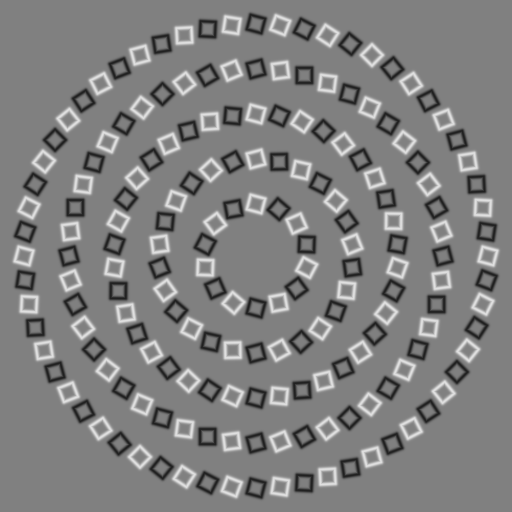Headache-Inducing Spiral Illusion Explained

Warning: This optical illusion might give you a headache. At a glance, the swirls of tilted black-and-white squares create the perception of a spiral. Look more closely and you realize that the squares don't form a coil at all; they trace out four perfectly round, concentric circles. The cognitive dissonance between your overall impression of spiraling and your recognition of individual circles … well, it hurts.
The illusion — called the "intertwining illusion" — has been a hit on social media recently, and it also happens to be the subject of study by researchers around the world. Because optical illusions harness the shift between what the eyes see and what the brain perceives, teasing out how that shift happens enables scientists to understand the inner workings of the human visual system.
When confronted with an optical illusion, or any other scene, "the visual system is interested in inferring what regions of an image are part of the same object or were made by the same process," explained Alvin Raj, a researcher in the Computer Science and Artificial Intelligence Lab at the Massachusetts Institute of Technology, who uses spiral illusions to study peripheral vision mechanisms.
But in this case, the visual system receives conflicting cues: Some say "circle," and some say "spiral." At the periphery of your vision, the spiral cues win.
"Peripheral vision does not accurately keep track of all the visual details, and so in some situations like in this illusion, the visual system makes errors," Raj told Life's Little Mysteries. "Notice that the illusion is strongest out in the periphery, and there is little illusion near the center of wherever you're staring in the image." [10 Everyday Things that Cause Brain Farts]
It's the tilted black-and-white squares that throw off your peripheral vision, according to Mark Changizi, an evolutionary anthropologist and director of human cognition at 2AI Labs in Boise, Idaho. Although the squares actually form rings, the tilt of the squares is consistent with a spiral, he explained. The offset between the black squares in one ring with the black squares in neighboring rings also creates the perception of a spiral, as does the offset between the white squares in adjacent rings. The spiral cues beat out the circle cues. "Once your visual system guesses that they may actually be spirals at the larger scale, it actually creates a perception of it being that way," Changizi said.
But how does your brain interpret this spiraling thing?
Sign up for the Live Science daily newsletter now
Get the world’s most fascinating discoveries delivered straight to your inbox.
Changizi explained that when the brain tries to make sense of complex stimuli, it "places its money" on 3D scenes it might actually be standing in front of, rather than 2D images that it didn't evolve to understand.
"So, when your brain decides that those rings are actually spirals, it's probably not deciding they're spirals lying within a flat surface in front of you. Instead, spirals in real life are more often due to something going in a circle while simultaneously changing in distance from you," Changizi wrote in an email. "For example, imagine walking through a tube, and there are stripes painted down the side. But instead of the stripes going straight down the tunnel, they twist around. Looking down the tunnel, you'll see spirals. If some twist in opposite directions, you'll see spirals that cut through one another (which is what's perceptually going on in this illusion)."
In other words, your brain probably thinks this is a tunnel receding into the distance, lined with two oppositely twisting candy cane-like stripes. Poor brain!
Follow Natalie Wolchover on Twitter @nattyover or Life's Little Mysteries @llmysteries. We're also on Facebook & Google+.
Natalie Wolchover was a staff writer for Live Science from 2010 to 2012 and is currently a senior physics writer and editor for Quanta Magazine. She holds a bachelor's degree in physics from Tufts University and has studied physics at the University of California, Berkeley. Along with the staff of Quanta, Wolchover won the 2022 Pulitzer Prize for explanatory writing for her work on the building of the James Webb Space Telescope. Her work has also appeared in the The Best American Science and Nature Writing and The Best Writing on Mathematics, Nature, The New Yorker and Popular Science. She was the 2016 winner of the Evert Clark/Seth Payne Award, an annual prize for young science journalists, as well as the winner of the 2017 Science Communication Award for the American Institute of Physics.










